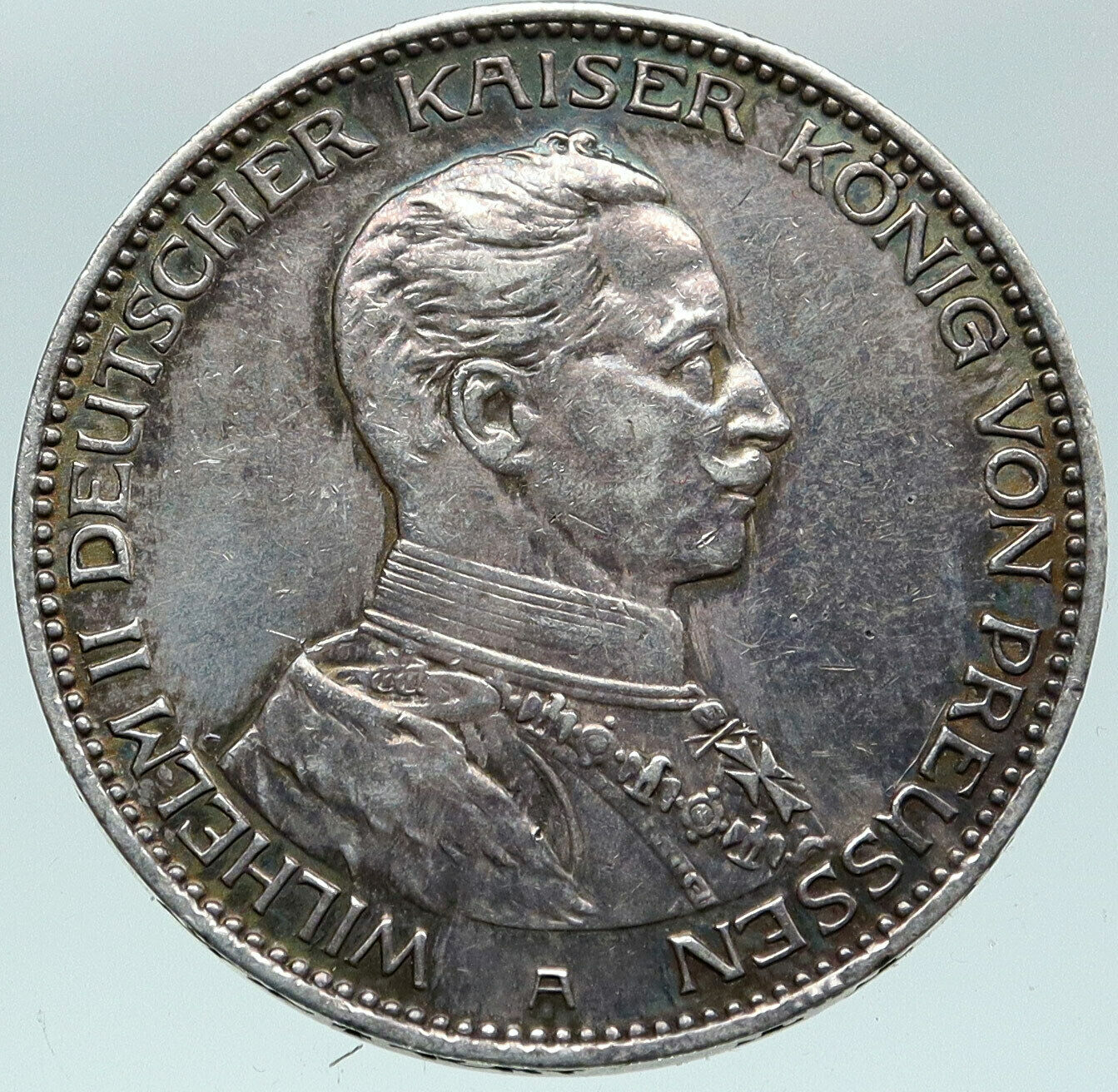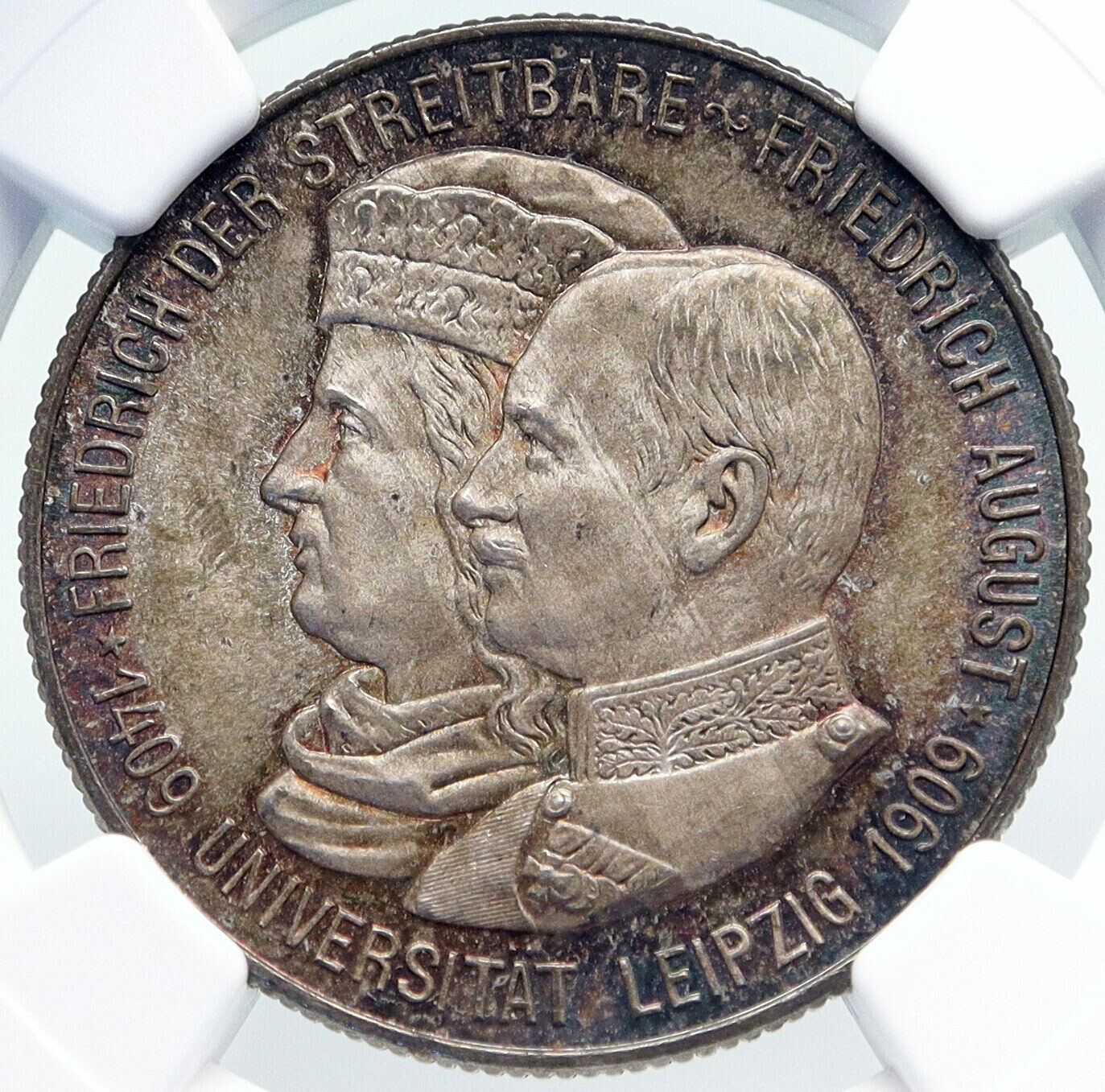|
Germany – German States – Bremen Free State
Shooting Festival
1865 B Silver Thaler 34mm (17.54 grams) 0.986 Silver (0.556 oz. ASW)
Reference: KM# 248, Thun# 126
Certification: NGC AU DETAILS 2863148-009
FREIE HANSESTADT BREMEN EIN THALER GOLD, Coat-of-arms.
ZWEITES DEUTSCHES BUNDES- SCHIESSEN IN BREMEN 1865 B, Wreath, crossed guns below.
Edge Lettering:
GOTT MIT UNS
You are bidding on the exact item pictured, provided with a Certificate of Authenticity and Lifetime Guarantee of Authenticity.
A shooting thaler (/ˈtɑːlər/ TAH-lər; German: Schützentaler; French: Écu de tir) is a silver coin in thaler size minted to commemorate a Schützenfest (French: Fête de tir) or free shooting (German: Freischiessen, French: Tir libre) in Switzerland.
In a narrow sense, Swiss Schützentaler are the silver coins equal in size and weight to the Swiss 5 francs coin minted on the occasion of one of the Eidgenössische Schützenfeste, or federal shooting festivals. Two such coins were issued by the cantonal mints of Graubünden (1842, denominated at 4 Swiss francs and Glarus (1847, denominated at 40 Batzen) prior to the establishment of the Federal Mint. Sometimes included as “shooting thaler” is a double thaler (10 francs) coin minted by Geneva and donated as cash prizes to the 1851 festival.
The Federal Mint has issued fifteen such coins with the nominal value of five francs, between 1855 and 1885. These coins were not intended as legal tender, even though they were issued by the federal mint with a nominal face value. Because they were minted to the official specifications of the 5 francs coin, they were nevertheless circulated de facto. After 1885, the federal mint was dissuaded from minting these semi-official coins on the part of the Latin Monetary Union. After the demise of the Monetary Union, the Swiss federal mint issued two further Schützentaler, in 1934 and 1939, for a total of twenty distinct Schützentaler (3 cantonal, 17 federal). Of the 22 cantons of the Swiss Confederation, 18 are represented in these coins, the exceptions being Uri, Appenzell, Aargau and Valais.
Most of the designs in the series depict strongly patriotic themes, frequently depicting the federal personification Helvetia alongside a cantonal or city personification, in some cases alluding to specific historical events. The entire series can be distinguished from the much more varied genre of shooting medals (Schützenmedaillen) by their adherence to the specifications of circulating coinage (with the exception of the three cantonal speciments, the Swiss 5 francs coin). All but the Stans (1861) and St. Gallen (1874) issues are denominated.
The term Schützentaler has been revived for commercially produced commemorative coins of thaler size offered on the collector’s market since the 1980s.
 Germany, officially the Federal Republic of Germany is a federal parliamentary republic in western-central Europe. It includes 16 constituent states and covers an area of 357,021 square kilometres (137,847 sq mi) with a largely temperate seasonal climate. Its capital and largest city is Berlin. With 81 million inhabitants, Germany is the most populous member state in the European Union. After the United States, it is the second most popular migration destination in the world. Germany, officially the Federal Republic of Germany is a federal parliamentary republic in western-central Europe. It includes 16 constituent states and covers an area of 357,021 square kilometres (137,847 sq mi) with a largely temperate seasonal climate. Its capital and largest city is Berlin. With 81 million inhabitants, Germany is the most populous member state in the European Union. After the United States, it is the second most popular migration destination in the world.
 Various Germanic tribes have occupied northern Germany since classical antiquity. A region named Germania was documented before 100 CE. During the Migration Period the Germanic tribes expanded southward. Beginning in the 10th century, German territories formed a central part of the Holy Roman Empire. During the 16th century, northern German regions became the centre of the Protestant Reformation. Various Germanic tribes have occupied northern Germany since classical antiquity. A region named Germania was documented before 100 CE. During the Migration Period the Germanic tribes expanded southward. Beginning in the 10th century, German territories formed a central part of the Holy Roman Empire. During the 16th century, northern German regions became the centre of the Protestant Reformation.
The rise of Pan-Germanism inside the German Confederation resulted in the unification of most of the German states in 1871 into the Prussian-dominated German Empire. After World War I and the German Revolution of 1918-1919, the Empire was replaced by the parliamentary Weimar Republic. The establishment of the Third Reich in 1933 led to World War II and the Holocaust. After 1945, Germany split into two states, East Germany and West Germany. In 1990, the country was reunified.
 In the 21st century, Germany is a great power and has the world’s fourth-largest economy by nominal GDP, as well as the fifth-largest by PPP. As a global leader in several industrial and technological sectors, it is both the world’s third-largest exporter and importer of goods. Germany is a developed country with a very high standard of living sustained by a skilled and productive society. It upholds a social security and universal health care system, environmental protection and a tuition free university education. In the 21st century, Germany is a great power and has the world’s fourth-largest economy by nominal GDP, as well as the fifth-largest by PPP. As a global leader in several industrial and technological sectors, it is both the world’s third-largest exporter and importer of goods. Germany is a developed country with a very high standard of living sustained by a skilled and productive society. It upholds a social security and universal health care system, environmental protection and a tuition free university education.
Germany was a founding member of the European Union in 1993. It is part of the Schengen Area, and became a co-founder of the Eurozone in 1999. Germany is a member of the United Nations, NATO, the G8, the G20, and the OECD. The national military expenditure is the 9th highest in the world. Known for its rich cultural history, Germany has been continuously the home of influential artists, philosophers, musicians, sportsmen, entrepreneurs, scientists and inventors.
|









 Germany, officially the Federal Republic of Germany is a federal parliamentary republic in western-central Europe. It includes 16 constituent states and covers an area of 357,021 square kilometres (137,847 sq mi) with a largely temperate seasonal climate. Its capital and largest city is Berlin. With 81 million inhabitants, Germany is the most populous member state in the European Union. After the United States, it is the second most popular migration destination in the world.
Germany, officially the Federal Republic of Germany is a federal parliamentary republic in western-central Europe. It includes 16 constituent states and covers an area of 357,021 square kilometres (137,847 sq mi) with a largely temperate seasonal climate. Its capital and largest city is Berlin. With 81 million inhabitants, Germany is the most populous member state in the European Union. After the United States, it is the second most popular migration destination in the world. Various Germanic tribes have occupied northern Germany since classical antiquity. A region named Germania was documented before 100 CE. During the Migration Period the Germanic tribes expanded southward. Beginning in the 10th century, German territories formed a central part of the Holy Roman Empire. During the 16th century, northern German regions became the centre of the Protestant Reformation.
Various Germanic tribes have occupied northern Germany since classical antiquity. A region named Germania was documented before 100 CE. During the Migration Period the Germanic tribes expanded southward. Beginning in the 10th century, German territories formed a central part of the Holy Roman Empire. During the 16th century, northern German regions became the centre of the Protestant Reformation. In the 21st century, Germany is a great power and has the world’s fourth-largest economy by nominal GDP, as well as the fifth-largest by PPP. As a global leader in several industrial and technological sectors, it is both the world’s third-largest exporter and importer of goods. Germany is a developed country with a very high standard of living sustained by a skilled and productive society. It upholds a social security and universal health care system, environmental protection and a tuition free university education.
In the 21st century, Germany is a great power and has the world’s fourth-largest economy by nominal GDP, as well as the fifth-largest by PPP. As a global leader in several industrial and technological sectors, it is both the world’s third-largest exporter and importer of goods. Germany is a developed country with a very high standard of living sustained by a skilled and productive society. It upholds a social security and universal health care system, environmental protection and a tuition free university education.




